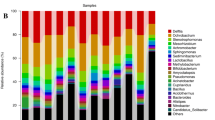Abstract
Cadmium toxicity reduces the species diversity of soil microbial communities and their ability to metabolize different carbon substrates. However, it is not yet clear whether there is a relationship between loss of species diversity and the metabolic rates at which different substrates are used. In this research, the ability of a soil microbial community to metabolize 31 C substrates was examined using Biolog Ecoplates amended with Cd over a range of concentrations (0, 5, 10, 20, 50 μg ml−1). After 48 h growth, the bacterial communities that were produced on ten of the substrates were characterized in relation to their 16S rDNA profiles by PCR denaturing-gradient gel electrophoresis. Results showed that both the microbial growth rates and the numbers of substrates that were used were reduced with increasing Cd concentration. When examined across all substrates, approximately 30% of the 16S rDNA bands representing different bacterial species were eliminated by 5 μg Cd ml−1. However, there was considerable variation in the bacterial community responses with different C substrates. Both cluster analysis and discriminant analysis indicated that the bacterial community structures could be grouped into sensitive, moderately sensitive, and Cd-resistant communities.




Similar content being viewed by others
References
Baath E, Frostegard A, Diaz-Ravina M, Tunlid A (1998) Microbial community-based measurements to estimate heavy metal effects in soil: the use of phospholipid fatty acid patterns and bacterial community tolerance. Ambio 27:58–61
Beveridge TJ, Hughes MN, Lee H, Leung KT, Poole RK, Savvaidis I, Silver S, Trevors JT (1997) Metal–microbe interactions: contemporary approaches. Adv Microb Physiol 38:177–243
Corbisier P (1997) Bacterial metal–lux biosensors for a rapid determination of the heavy metal bioavailability and toxicity in solid samples. Res Microbiol 148:534–536
Corbisier P, Thiry E, Diels L (1996) Bacterial biosensors for the toxicity assessment of solid wastes. Environ Toxicol Water Qual 11:171–177
Doelman P, Jansen E, Michels M, Van Til M (1994) Effects of heavy metals in soil on microbial diversity and activity as shown by the sensitivity-resistance index, an ecologically relevant parameter. Biol Fertil Soils 17:177–184
Farrah H, Pickering WF (1993) Factors influencing the potential mobility and bioavailability of metals in dried lake sediments. Chem Spec Bioavail 5:81–96
Frostegard A, Tunlid A, Baath E (1993) Phospholipid fatty acid composition, biomass, and activity of microbial communities from two soil types experimentally exposed to different heavy metals. Appl Environ Microbiol 59:3605–3617
Garland JL (1997) Analysis and interpretation of community-level physiological profiles in microbial ecology. FEMS Microbiol Ecol 24:289–300
Gilis A, Corbisier P, Baeyens W, Taghavi S, Mergeay M, Van Der Lelie D (1998) Effect of the siderophore alcaligin E on the bioavailability of Cd to Alcaligenes eutrophus CH34. J Ind Microbiol Biotechnol 20:61–68
Giller KE, Witter E, McGrath SP (1998) Toxicity of heavy metals to microorganisms and microbial processes in agricultural soils: a review. Soil Biol Biochem 30:1389–1414
Griffiths BS, Diaz-Ravina M, Ritz K, McNicol JW, Ebblewhite N, Baath E (1997) Community DNA hybridisation and %G+C profiles of microbial communities from heavy metal polluted soils. FEMS Microbiol Ecol 24:103–112
Ivask A, Virta M, Kahru A (2002) Construction and use of specific luminescent recombinant bacterial sensors for the assessment of bioavailable fraction of cadmium, zinc, mercury and chromium in the soil. Soil Biol Biochem 34:1439–1447
Kandeler E, Tscherko D, Bruce KD, Stemmer M, Hobbs PJ, Bardgett RD, Amelung W (2000) Structure and function of the soil microbial community in microhabitats of a heavy metal polluted soil. Biol Fertil Soils 32:390–400
Knight BP, McGrath SP, Chaudri AM (1997) Biomass carbon measurements and substrate utilization patterns of microbial populations from soils amended with cadmium copper, or zinc. Appl Environ Microbiol 63:39–43
Konopka A, Oliver L, Turco RF (1998) The use of carbon substrate utilization patterns in environmental and ecological microbiology. Microb Ecol 35:103–115
Murray P, Ge Y, Hendershot WH (2000) Evaluating three trace metal contaminated sites: a field and laboratory investigation. Environ Pollut 107:127–135
Ovreas L, Forney L, Daae FL, Torsvik V (1997) Distribution of bacterioplankton in meromictic Lake Saelenvannet, as determined by denaturing gradient gel electrophoresis of PCR-amplified gene fragments coding for 16SrRNA. Appl Environ Microbiol 63:3367–3373
Reber HH (1992) Simultaneous estimates of the diversity and the degradative capability of heavy-metal-affected soil bacterial communities. Biol Fertil Soils 13:181–186
Roane TM, Pepper IL (1999) Microbial responses to environmentally toxic cadmium. Microb Ecol 38:358–364
Smalla K, Wachtendorf U, Heuer H, Liu W-T, Forney L (1998) Analysis of Biolog GN substrate utilization patterns by microbial communities. Appl Environ Microbiol 64:1220–1225
Stephen JR, Chang Y-J, Macnaughton SJ, Kowalchuk GA, Leung KT, Flemming CA, White DC (1999a) Effect of toxic metals on indigenous soil beta-subgroup proteobacterium ammonia oxidizer community structure and protection against toxicity by inoculated metal-resistant bacteria. Appl Environ Microbiol 65:95–101
Stephen JR, Chang Y-J, MacNaughton SJ, Whitaker SL, Hicks CL, Leung KT, Flemming CA, White DC (1999b) Fate of a metal-resistant inoculum in contaminated and pristine soils assessed by denaturing gradient gel electrophoresis. Environ Toxicol Chem 18:1118–1123
Van Beelen P, Doelman P (1997) Significance and application of microbial toxicity tests in assessing ecotoxicological risks of contaminants in soil and sediment. Chemosphere 34:455–499
Yang C-H, Crowley DE (2000) Rhizosphere microbial community structure in relation to root location and plant iron nutritional status. Appl Environ Microbiol 66:345–351
Acknowledgements
This research was supported by a grant from the U.S. Department of Energy. The authors also gratefully acknowledge the technical assistance of May Chen.
Author information
Authors and Affiliations
Corresponding author
Rights and permissions
About this article
Cite this article
Wang, A., Chen, J. & Crowley, D.E. Changes in metabolic and structural diversity of a soil bacterial community in response to cadmium toxicity. Biol Fertil Soils 39, 452–456 (2004). https://doi.org/10.1007/s00374-003-0708-0
Received:
Accepted:
Published:
Issue Date:
DOI: https://doi.org/10.1007/s00374-003-0708-0




